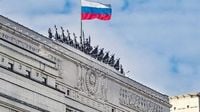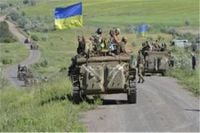In a dramatic escalation of hostilities, the Ukrainian Armed Forces reported on Sunday, April 6, 2025, that they engaged in 178 combat clashes with the Russian military over the preceding 24 hours. This surge in conflict comes as tensions remain high in the region, particularly in the Bakhmut sector, which has been identified as the focal point of intense fighting between the two nations.
The Ukrainian General Staff detailed that the Russian army launched a staggering 99 airstrikes targeting Ukrainian units and towns, deploying 163 guided bombs and firing approximately 5,449 shells. Among these, 123 were launched using multiple rocket systems, accompanied by the use of 2,237 unmanned aerial vehicles (UAVs) in what appears to be a concerted effort to overwhelm Ukrainian defenses.
In response to these aggressive maneuvers, Ukrainian forces struck back, targeting 12 locations where Russian troops and military equipment were stationed, alongside Russian air defense installations. This reciprocal barrage underscores the ongoing tit-for-tat nature of the conflict, with both sides suffering significant losses.
Meanwhile, the Russian Defense Ministry reported that Ukraine had conducted seven attacks on energy infrastructure within the last 24 hours. These strikes were aimed at facilities located in Crimea, Bryansk, Rostov, and Voronezh, with one attack causing damage to a gas pipeline in the Voronezh region. The Russian military condemned these assaults as provocative and deliberate.
Ukrainian President Volodymyr Zelenskyy commented on the situation, asserting that the frequency of Russian attacks indicates that international pressure on President Putin's regime has not been effective. “The volume of daily Russian attacks on Ukrainian territory clearly reflects that the international pressure on Moscow remains below the necessary level,” Zelenskyy stated in remarks reported by Cairo News.
In a stark warning, Zelenskyy noted that Russian forces had launched over 1,460 guided bombs, 670 drones, and 30 missiles of various types in the past week alone. He highlighted that the night prior saw missile strikes targeting key Ukrainian cities such as Kyiv, Mykolaiv, Sumy, and Kharkiv.
Andriy Sybiha, Ukraine's Foreign Minister, echoed Zelenskyy's concerns, calling for increased pressure on Russia to bring an end to the conflict. He pointed out that the only response from Russia to American proposals for a ceasefire has been to escalate its missile and drone attacks on Ukraine.
Adding to the complexity of the situation, the Russian Defense Ministry announced a missile strike on a meeting of Ukrainian leaders and foreign trainers in Kryvyi Rih, which reportedly resulted in the deaths and injuries of 85 military personnel, both Ukrainian and foreign. This attack serves as a grim reminder of the stakes involved in this ongoing conflict.
Furthermore, the Russian Foreign Ministry condemned Ukraine's attacks on Russian energy facilities, labeling them as provocative. In a statement, the ministry declared that Ukraine's strikes on Russian energy infrastructure were deliberate acts of aggression.
Despite the ongoing conflict, Zelenskyy has expressed skepticism regarding Russia's sincerity in pursuing peace talks, stating, “The large-scale Russian attacks on our territories after ceasefire negotiations are a clear indication that Moscow is not seeking peace.” His comments reflect a growing frustration among Ukrainian leadership regarding the lack of genuine dialogue and resolution.
The Kremlin has responded to these developments by asserting that Ukraine's continued targeting of Russian energy facilities demonstrates its inability to engage in meaningful negotiations. This back-and-forth rhetoric underscores the deepening divide between the two nations.
As the conflict continues, the international community remains watchful, with many fearing that the situation could spiral further out of control. The humanitarian implications of this war are dire, and the toll on civilians is mounting as both sides engage in increasingly aggressive tactics.
In summary, the recent surge in combat between Ukrainian and Russian forces highlights the ongoing volatility in the region. With both nations ramping up their military operations, the prospect of a peaceful resolution appears increasingly distant. The international community must navigate these turbulent waters carefully, as the consequences of further escalation could be catastrophic.





